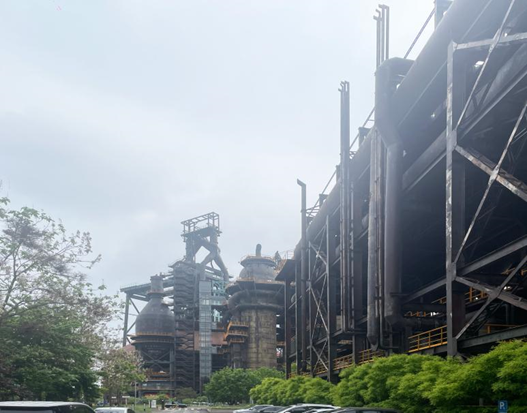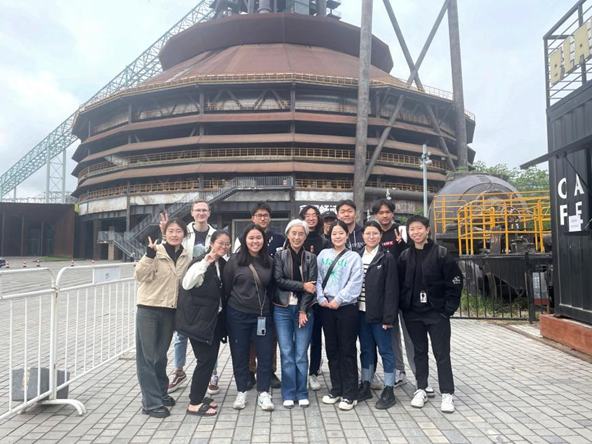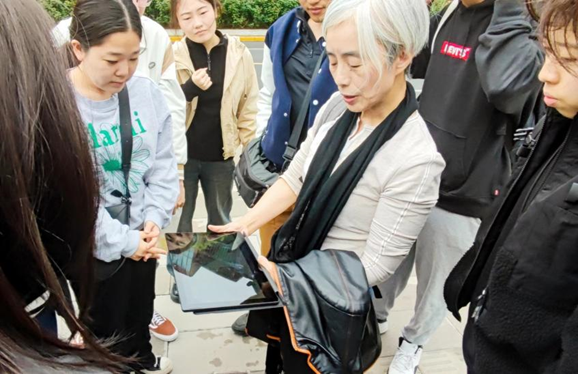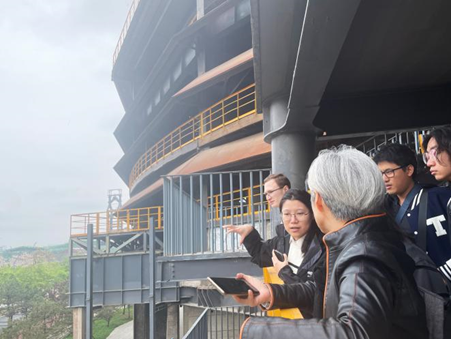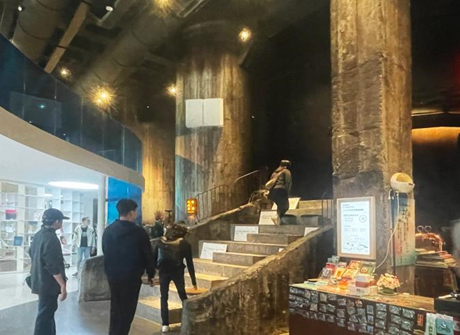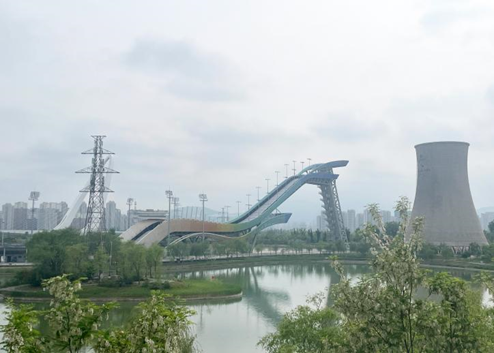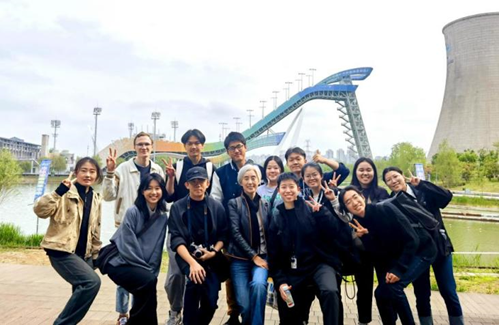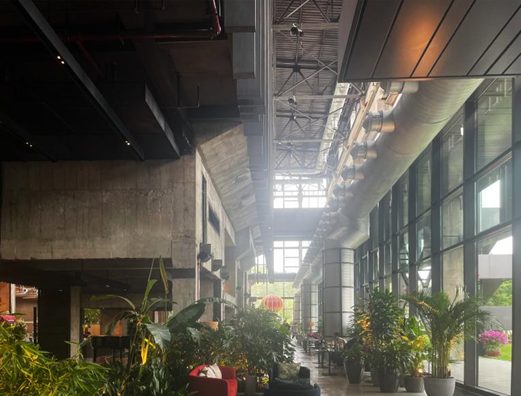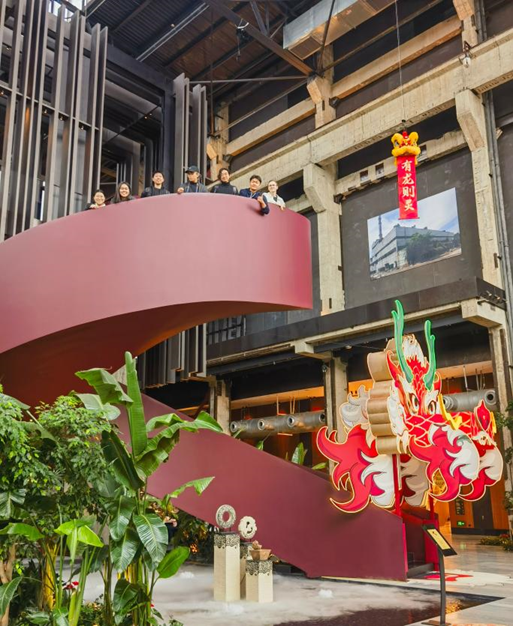建筑學(xué)碩士英文項(xiàng)目(EPMA)學(xué)生參觀首鋼園
2024.05-12
2024年4月29日,清華大學(xué)建筑學(xué)院建筑學(xué)碩士英文項(xiàng)目(EPMA)2023級(jí)同學(xué)結(jié)合課程教學(xué)�,前往北京首鋼園進(jìn)行參觀調(diào)研����,實(shí)地了解首鋼園區(qū)在冬奧會(huì)大事件帶動(dòng)下���,實(shí)現(xiàn)全面轉(zhuǎn)型發(fā)展的成功探索�。On 29 April 2024, students of the English Program for Master in Architecture (EPMA) 2023, School of Architecture, Tsinghua University, in conjunction with their course teaching, visited Beijing Shougang Park for research, to learn on the ground about the successful exploration of Shougang Park's comprehensive transformation and development, driven by the Winter Olympics.2005年�����,首鋼老工業(yè)區(qū)開始搬遷調(diào)整���,園區(qū)整體轉(zhuǎn)型發(fā)展�,隨著工業(yè)遺產(chǎn)的保護(hù)和冬奧組委的入駐��,老廠區(qū)逐漸改造為以鋼鐵工業(yè)文化遺存為特色的主題文化園區(qū)���。曾經(jīng)的“十里鋼城”�,如今已轉(zhuǎn)型為一座大型工業(yè)遺址生態(tài)文化園,成為北京城市深度轉(zhuǎn)型的重要標(biāo)志����。In 2005, Shougang Industrial Zone began its relocation and adjustment, and the park underwent overall transformation and development. With the protection of industrial heritage and the entry of the Winter Olympics Organizing Committee, the old factory area gradually transformed into a themed cultural park with steel industry cultural relics as its characteristic. The former "The Great Steel Wall" has now transformed into a large-scale industrial site ecological and cultural park, becoming an important symbol of Beijing's deep urban transformation.在任課教師的帶領(lǐng)下,同學(xué)們沿群明湖大街和秀池北路依次參觀了首鋼園三高爐��、西十筒倉(cāng)����、首鋼園滑雪大跳臺(tái)、群名湖����、北區(qū)六工會(huì)、首鋼空中步道��、香格里拉酒店等首鋼園重要節(jié)點(diǎn)����。Under the guidance of the teacher, the students followed Qunminghu Street and Xiuchi North Road to visit the ‘San Gao’ furnace, ‘Xi Shi’ silos, Ski Jumping Platform, Qunming Lake, North District Sixth Industrial Union, Shougang Skywalk, Shangri-la Hotel and other important places in Shougang Park.在秀池前,同學(xué)們認(rèn)真聆聽(tīng)了首鋼園的發(fā)展歷程和規(guī)劃講解���。北端西十冬奧廣場(chǎng)在尊重現(xiàn)狀機(jī)理的基礎(chǔ)上��,利用首鋼原有工業(yè)材料織補(bǔ)更新��,組織辦公功能與交通流線�,展現(xiàn)莊重的儀式感與多元文化氛圍。In front of Xiuchi, the students carefully listened to the development process and planning explanation of Shougang Park. On the basis of respecting the current situation and mechanism, the Winter Olympics Square on the North utilized the original industrial materials of Shougang to weave, update and organize the office functions and traffic flow, while displaying a solemn sense of ceremony and a multicultural atmosphere.脫硫車間�、焦化廠、高爐改造等重要節(jié)點(diǎn)�����,依托現(xiàn)狀皮帶通廊和管道���,組織空中步行走廊,老師同學(xué)走進(jìn)三高爐改造后的藝術(shù)書店和文創(chuàng)空間��,真切感受工業(yè)遺址的原真化保留與改造��。Important nodes such as desulfurization workshop, coking plant, and blast furnace renovation, organized aerial pedestrian corridors relying on the current belt corridors and pipelines. Professor and students entered the art bookstore and cultural and creative space which are the renovation of the three blast furnaces, and experienced the authenticity preservation of industrial sites.圖:師生于改造后的文創(chuàng)區(qū)進(jìn)行調(diào)研參觀沿空中步道����,同學(xué)們眺望北部石景山,感受自然山水古建筑群與園區(qū)工業(yè)遺存形成的多元復(fù)合有機(jī)共存系統(tǒng)��。山水環(huán)抱的兩湖區(qū)域�����,首鋼園尊重原有建筑和綠地肌理,保留并改造長(zhǎng)達(dá)200余米的精煤車間���,滑雪大跳臺(tái)所在的濱水區(qū)域與永定河生態(tài)走廊的景觀銜接�����,以開放的姿態(tài)融入城市系統(tǒng)����。Along the skywalk, students looked out over Shijingshan mountain in the north and experienced the multi-compound organic coexistence system formed by natural landscape and ancient buildings, as well as industrial relics of the park. Surrounded by mountains and rivers, Shougang Park respects the original architecture and green space fabric, retained and transformed the coal cleaning workshop with a length of more than 200 meters, and connected the waterfront area where the ski jump platform is located with the landscape of the Yongding River ecological corridor, integrating into the urban system with an open attitude.圖:滑雪大跳臺(tái)所在濱水區(qū)域?qū)崨r改造于首鋼電力廠的香格里拉酒店�,創(chuàng)新性詮釋了綠色可持續(xù)與鋼筋水泥的融合。保留的部分廠房排架柱等標(biāo)志性構(gòu)件����,以新舊材料對(duì)比、新舊空間對(duì)比���,延續(xù)老首鋼的工業(yè)之美��。Shangri-la Hotel, renovated in Shougang Power Plant, innovatively interprets the integration of sustainability with steel and concrete. Some of the retained plant columns and other iconic components, with the contrast of old and new materials and spaces, continued the industrial beauty of the old Shougang.圖:首鋼園香格里拉酒店內(nèi)部實(shí)況圖:學(xué)生于首鋼園香格里拉內(nèi)部合影此次教學(xué)活動(dòng)在完成既有教學(xué)目標(biāo)�,強(qiáng)化研究生的城市建筑研究能力的同時(shí)���,旨在強(qiáng)化國(guó)際學(xué)生對(duì)北京城市建設(shè)發(fā)展歷程的認(rèn)識(shí)�����,以及北京探索存量時(shí)代產(chǎn)業(yè)轉(zhuǎn)型��、生態(tài)低碳��、歷史傳承等議題的成功路徑���。This teaching activity aims to complete the existing teaching objectives and strengthen the cognition of international students in the development history of Beijing's urban construction.and the successful paths that Beijing has taken in exploring the topics of industrial transformation, sustainability and historical inheritance in the stock era.Ee Zian余子安(馬來(lái)西亞):首鋼之行給了我深刻的啟發(fā)���!老師的評(píng)論提供了寶貴的見(jiàn)解��,使我對(duì)這個(gè)坐落在繁華的北京都市中的獨(dú)特項(xiàng)目有了更深入的理解��。親身體驗(yàn)到這片工業(yè)區(qū)域如何在現(xiàn)代城市景觀中蛻變?yōu)槌錆M活力的文化中心��,確實(shí)讓我受益匪淺����。這次經(jīng)歷不僅拓寬了我對(duì)城市發(fā)展的認(rèn)識(shí),也深深激發(fā)了我對(duì)塑造城市未來(lái)的創(chuàng)新努力的敬意��。Ee Zian ( Malaysia ) : The Shougang trip was greatly inspiring! The teacher's insightful commentary provided invaluable insights, deepening my understanding of this unique project nestled within the bustling metropolis of Beijing. Experiencing firsthand how this industrial area has transformed into a vibrant cultural hub amid the modern urban landscape was truly enlightening. This experience not only broadened my understanding of urban development but also instilled a deep sense of appreciation for the innovative endeavors shaping the future of our cities.Kim Younwoo 金潤(rùn)宇(韓國(guó)):通過(guò)實(shí)際踏足首鋼園區(qū),在課堂上學(xué)習(xí)到的城市規(guī)劃�����、工業(yè)遺產(chǎn)保護(hù)等內(nèi)容都在這里得到了生動(dòng)的驗(yàn)證與實(shí)踐��。站在廠房�����、鍋爐和軌道旁��,我感受到了工業(yè)建筑的獨(dú)特的韻味與功能轉(zhuǎn)化的可能性�����;而園區(qū)內(nèi)部的文化創(chuàng)意產(chǎn)業(yè)則展現(xiàn)了城市更新與轉(zhuǎn)型發(fā)展的成果����。這次體驗(yàn)讓我深信,通過(guò)實(shí)地考察����,才能更好地理解課堂上的知識(shí),將理論與實(shí)踐相結(jié)合�,才能更好地為城市的未來(lái)發(fā)展貢獻(xiàn)力量��。Kim Younwoo ( South Korea ) : By actually stepping into the Shougang Park, the knowledge about urban planning and industrial heritage preservation that we learned in the class were vividly validated and practiced here. Standing beside the factories, boilers, and railways, I felt the unique charm of industrial architecture and the potential for functional transformation. Meanwhile, the cultural and creative industries within the park showcased the achievements of urban renewal and transformation. This experience deeply convinced me that only through field visits can we better understand the knowledge taught in the class. It is through integrating theory with practice that we can better contribute to the future development of cities.
